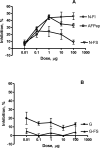Design and synthesis of biologically active peptides: a 'tail' of amino acids can modulate activity of synthetic cyclic peptides
- PMID: 22015269
- PMCID: PMC3230782
- DOI: 10.1016/j.peptides.2011.10.007
Design and synthesis of biologically active peptides: a 'tail' of amino acids can modulate activity of synthetic cyclic peptides
Abstract
In earlier work, we synthesized a cyclic 9-amino acid peptide (AFPep, cyclo[EKTOVNOGN]) and showed it to be useful for prevention and therapy of breast cancer. In an effort to explore the structure-function relationships of AFPep, we have designed analogs that bear a short 'tail' (one or two amino acids) attached to the cyclic peptide distal to its pharmacophore. Analogs that bore a tail of either one or two amino acids, either of which had a hydrophilic moiety in the side chain (e.g., cyclo[EKTOVNOGN]FS) exhibited greatly diminished biological activity (inhibition of estrogen-stimulated uterine growth) relative to AFPep. Analogs that bore a tail of either one or two amino acids which had hydrophobic (aliphatic or aromatic) side chains (e.g., cyclo[EKTOVNOGN]FI) retained (or had enhanced) growth inhibition activity. Combining in the same biological assay a hydrophilic-tailed analog with either AFPep or a hydrophobic-tailed analog resulted in decreased activity relative to that for AFPep or for the hydrophobic-tailed analog alone, suggesting that hydrophilic-tailed analogs are binding to a biologically active receptor. An analog with a disrupted pharmacophore (cyclo[EKTOVGOGN]) exhibited little or no growth inhibition activity. An analog with a hydrophilic tail and a disrupted pharmacophore (cyclo[EKTOVGOGN]FS) exhibited no growth inhibition activity of its own and did not affect the activity of a hydrophobic-tailed analog, but enhanced the growth inhibition activity of AFPep. These results are discussed in the context of a two-receptor model for binding of AFPep and ring-and-tail analogs. We suggest that tails on cyclic peptides may comprise a useful method to enhance diversity of peptide design and specificity of ligand-receptor interactions.
Copyright © 2011 Elsevier Inc. All rights reserved.
Figures



Similar articles
-
Antiestrogenic and anticancer activities of peptides derived from the active site of alpha-fetoprotein.J Pept Sci. 2009 Apr;15(4):319-25. doi: 10.1002/psc.1119. J Pept Sci. 2009. PMID: 19189271
-
Development of a synthetic cyclized peptide derived from alpha-fetoprotein that prevents the growth of human breast cancer.J Pept Res. 2001 Sep;58(3):246-56. doi: 10.1034/j.1399-3011.2001.00922.x. J Pept Res. 2001. PMID: 11576331
-
Synthetic peptide derived from alpha-fetoprotein inhibits growth of human breast cancer: investigation of the pharmacophore and synthesis optimization.J Pept Res. 2004 May;63(5):409-19. doi: 10.1111/j.1399-3011.2004.00139.x. J Pept Res. 2004. PMID: 15140158
-
Development of an active site peptide analog of α-fetoprotein that prevents breast cancer.Cancer Prev Res (Phila). 2014 Jun;7(6):565-73. doi: 10.1158/1940-6207.CAPR-13-0405. Epub 2014 Apr 4. Cancer Prev Res (Phila). 2014. PMID: 24706695 Review.
-
Azumamides A-E: Isolation, Synthesis, Biological Activity, and Structure-Activity Relationship.Molecules. 2022 Dec 2;27(23):8438. doi: 10.3390/molecules27238438. Molecules. 2022. PMID: 36500529 Free PMC article. Review.
Cited by
-
Dataset on substituents effect on biological activities of linear RGD-containing peptides as potential anti-angiotensin converting enzyme.Data Brief. 2023 Aug 6;50:109478. doi: 10.1016/j.dib.2023.109478. eCollection 2023 Oct. Data Brief. 2023. PMID: 37600591 Free PMC article.
-
Transcriptome and Metabolome Analyses Reveal Molecular Responses of Two Pepper (Capsicum annuum L.) Cultivars to Cold Stress.Front Plant Sci. 2022 Mar 22;13:819630. doi: 10.3389/fpls.2022.819630. eCollection 2022. Front Plant Sci. 2022. PMID: 35392507 Free PMC article.
-
Peptide ligands for targeting the extracellular domain of EGFR: Comparison between linear and cyclic peptides.Chem Biol Drug Des. 2018 Feb;91(2):605-619. doi: 10.1111/cbdd.13125. Epub 2017 Nov 16. Chem Biol Drug Des. 2018. PMID: 29052959 Free PMC article.
References
-
- Bennett JA, Defreest L, Anaka I, Saadati H, Balulad S, Jacobson HI, et al. AFPep: an anti-breast cancer peptide that is orally active. Breast Cancer Res Treat. 2006 Mar 15;98(2):133–41. - PubMed
-
- Bennett JA, Semeniuk DJ, Jacobson HI, Murgita RA. Similarity between natural and recombinant human alpha-fetoprotein as inhibitors of estrogen-dependent breast cancer growth. Breast Cancer Res Treat. 1997 Sep;45(2):169–79. - PubMed
-
- Bennett JA, Zhu S, Pagano-Mirarchi A, Kellom TA, Jacobson HI. Alpha-fetoprotein derived from a human hepatoma prevents growth of estrogen-dependent human breast cancer xenografts. Clin Cancer Res. 1998 Nov;4(11):2877–84. - PubMed
Publication types
MeSH terms
Substances
Grants and funding
LinkOut - more resources
Full Text Sources

